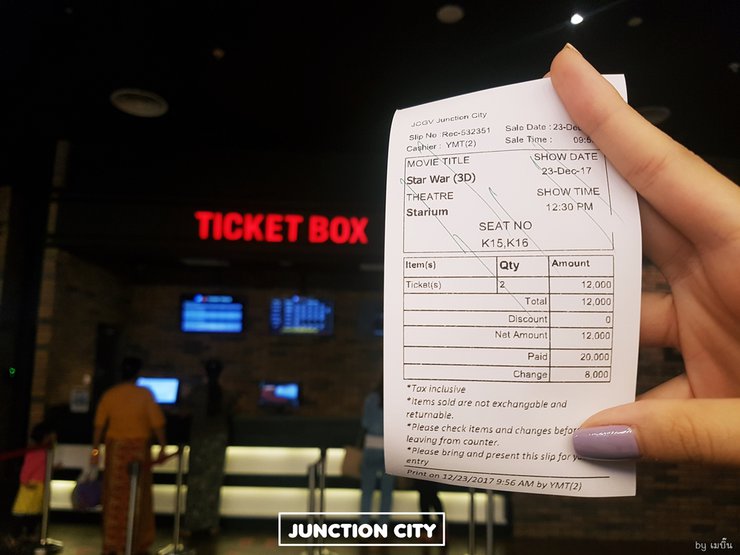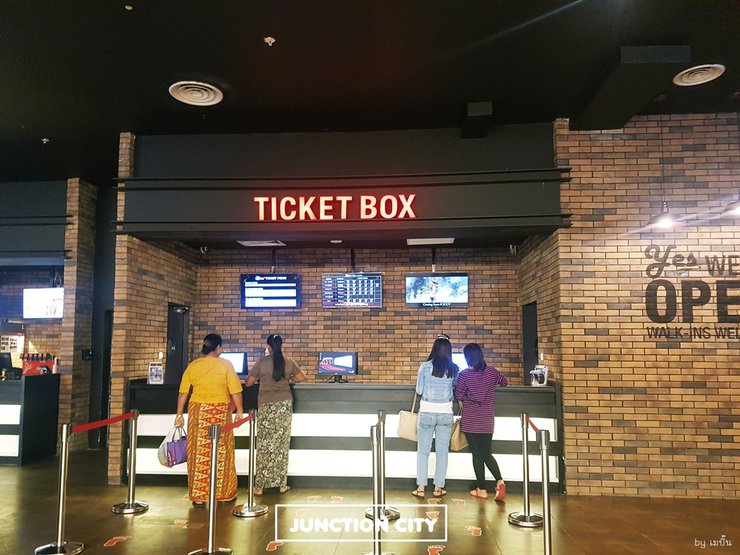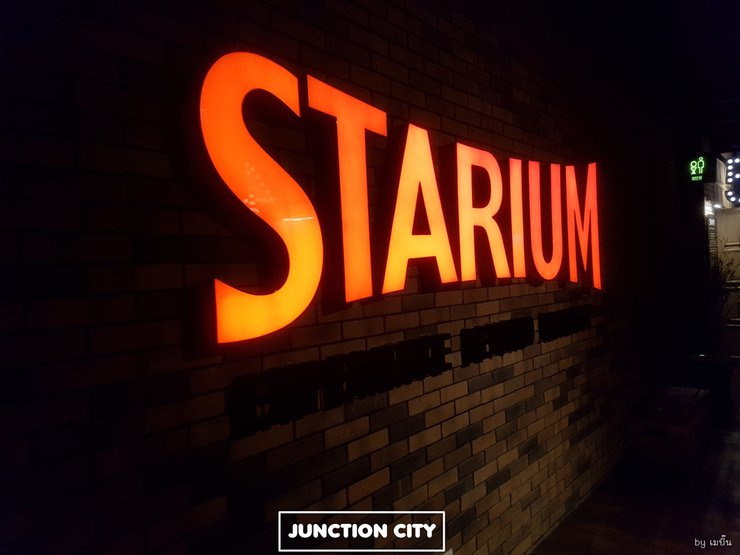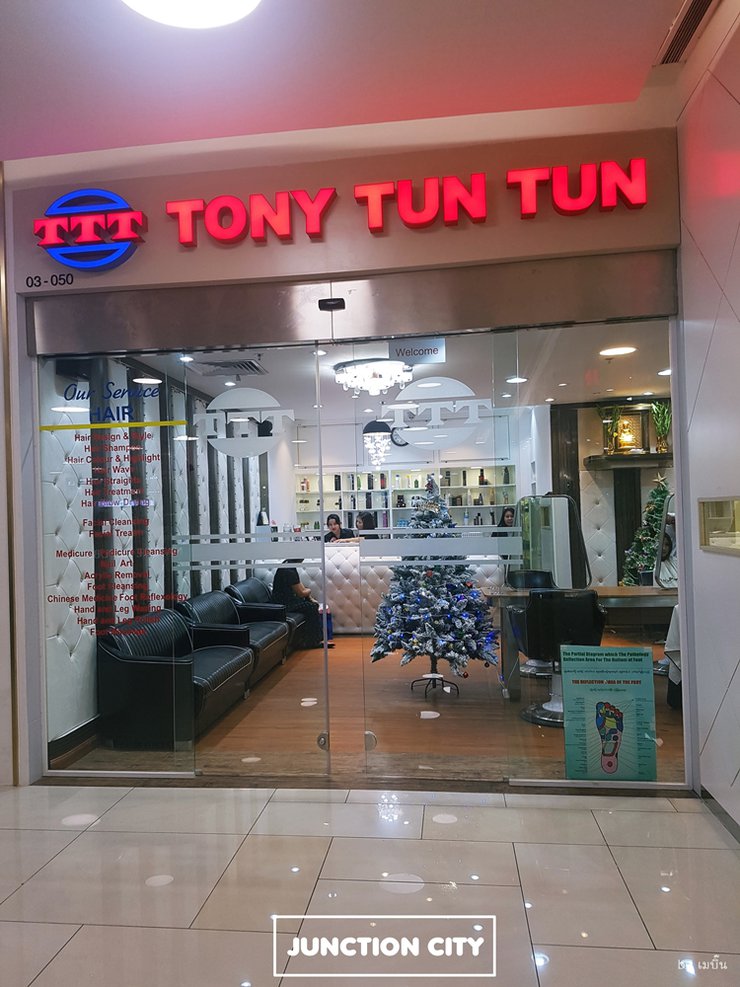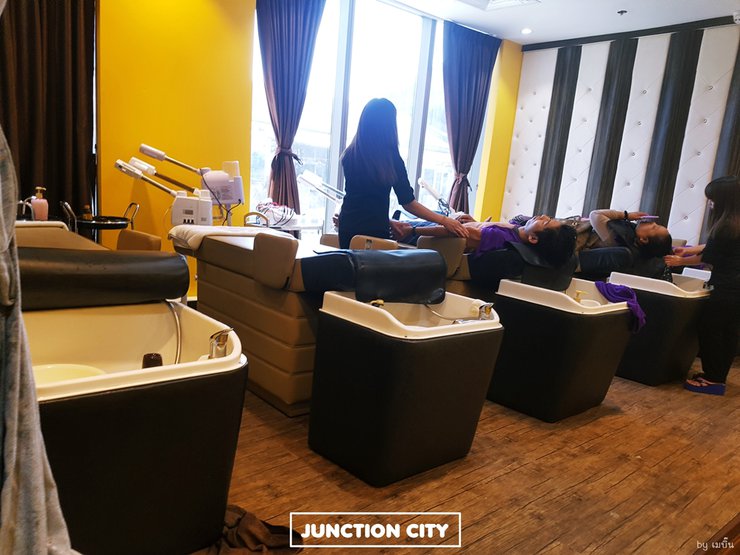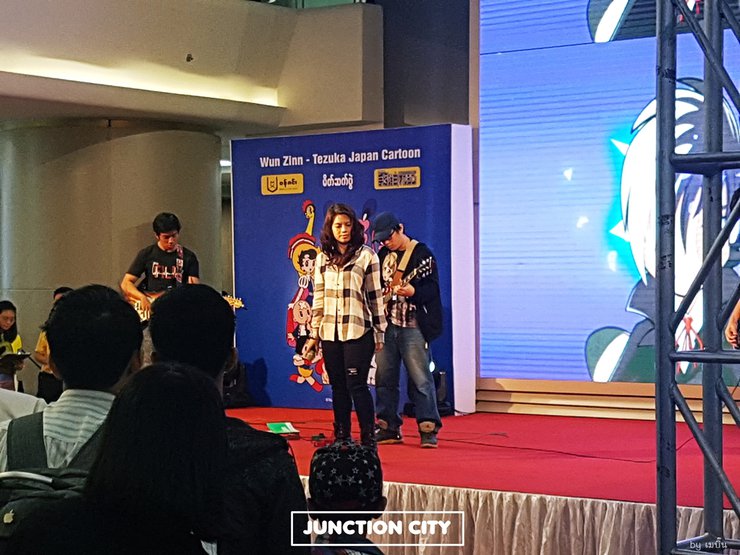CHAPTER 2: Experiencing Life as a Burmese Teenager

The truth is, we don't really know what they do. Based on what my Burmese friend (Peter) told me, they go to karaoke, watch movies, and go to the mall. In other words, their lifestyle is exactly the same as that of Thai people. But since we're here, let's try living a Thai lifestyle in Burma.
While many visitors to Myanmar choose to visit temples and pagodas to seek blessings, we opted to explore Yangon on our own terms, focusing on aspects beyond religious sites. Given the abundance of temple reviews available, we felt it was more valuable to delve into the city's other offerings.
The mall near our accommodation, Junction City, seemed to be newly opened, with everything looking relatively new. The staff in the shops were incredibly attentive. We were looking for socks, and when we couldn't find them in one store, we went to another. Upon returning to the first store, the staff still greeted us with a smile. We almost went back to buy something just because of their service, but unfortunately, they didn't have what we needed. The customer service here is excellent, especially in the mall. We would rate it 4.95 out of 5, just to avoid any accusations of bias. We had planned to watch a movie in Myanmar during our trip, curious to see how the experience differed from Thailand. Junction Mall opens at 9:00 AM. After breakfast and finishing our errands, we went to check the movie showtimes around 10:30 AM.
The movie theater in Junction City mall


This movie theater is located on the 5th floor of the mall. It offers ticket booking services at the counter, similar to Thailand. However, the movie tickets are different. Here, you only get a slip that shows the movie title, seat number, and amount paid. Peter mentioned that this mall has the most expensive movie tickets. We chose seats that cost around 150 baht (there are cheaper and more expensive options). The seats were comfortable and wider than those at Major Cineplex. The movie theater has about 5-6 screens. Today, we watched Star Wars in 3D, so it was shown in a special theater (Starium). Before the movie started, there was a standing ceremony similar to Thailand, but it only played music and displayed the Myanmar flag. We had to stand during the ceremony and bow when the music ended. The popcorn here is less flavorful than in Thailand. Speaking of Star Wars, this movie theater doesn't have a Burmese dub. It only has the original English audio with no English subtitles. For those with a low level of English and who haven't seen any Star Wars movies before, I must say that we dozed off. We woke up and the movie wasn't even finished yet. However, the most exciting scenes for us were the ones without dialogue, featuring action-packed lightsaber duels and spaceships flying around. It was thrilling and visually stunning thanks to the 3D technology. The staff was attentive, and most of them spoke English, from the ticket sellers and popcorn vendors to the ticket checkers at the theater entrance. Their English was excellent.


"Salon ร้านทำผมในย่างกุ้ง"
Our initial impression of Myanmar's hair salons was that they resembled roadside salons in Thailand. We didn't expect much, assuming they would be similar in quality. However, we were pleasantly surprised by the prices and the excellent service we received. We chose a salon based on the number of customers waiting. One salon was empty, while the other had several people waiting (presumably for their turn). We opted for the latter, which was located in Junction Mall and called Tony Tun Tun.
Everything about the salon was impressive. The equipment was modern, the staff was friendly and attentive, and the shampooing experience was exceptional. We've noticed that hair washing techniques vary significantly across countries. In Vietnam, for instance, a head massage is included with the shampoo. While the hair wash itself was average, our face felt incredibly refreshed afterwards. In Myanmar, the salon offered a scalp massage during the shampooing process. Each application of shampoo and conditioner was accompanied by a gentle massage, which was incredibly relaxing. The shampoo itself had a wonderful fragrance.
After the shampoo, our hair was blow-dried and cut. The stylist was a man. Initially, we only intended to get a simple trim, so we chose a style on the spot. When the initial cut was longer than we expected, the stylist happily made adjustments without complaint. (In our experience, some stylists in Thailand might grumble about not being told the desired length beforehand.) Ultimately, we achieved the desired hairstyle. Additionally, this was the first salon where we were offered ear cleaning after the hair wash, which was a thoughtful touch.
On our way to the cinema (12:30 pm show), we walked around the mall to kill time. We noticed that there was a cosplay competition event happening at the mall. This is probably a regular occurrence in Thailand.
"Cosplay Competition Event in Yangon"

Our travel companions were amazed by the event here, to the point of being overwhelmed. They said they hadn't dressed up in cosplay and attended an event like this in a long time. We saw and looked into it. We had never been to a cosplay event before in our lives. It was a lot of fun for us too. There were young children dressed up in cute costumes as various cartoon characters. So we went to ask for a picture, and they let us take it without any hesitation. There were so many cartoon characters, both familiar and unfamiliar. But it seemed like our companions knew almost all of them. 555555
The stage performance started with excitement. It was fun. There were singers singing anime songs. We could only sway and have fun. And the otaku of Yangon were also swaying in front of the stage. I saw you guys singing along to every song! This event made us realize that Myanmar has only recently opened up to the world and is rapidly embracing foreign cultures. Previously, they were under a dictatorship. Now they have much more freedom. As they embrace other cultures, everything is moving forward rapidly. And they are adapting well. If we were a business, one of the options for expanding our business would be Myanmar. There are still many things that are ready for us to build on. Most young people are also ready to embrace it.
Regarding food, we went crazy for Korean cuisine. Honestly, we didn't expect much from Burmese food. The only medicine we brought with us was Rabbit Brand White Water Medicine, which we were confident we would need. We were afraid of having stomach problems. In the end, Myanmar turned out to be a culinary paradise. We could find anything we wanted to eat. Everything was readily available, from Western food (such as steaks) to authentic Burmese cuisine (which emphasizes spicy and sweet flavors), Indian food (found on almost every street corner, as there are many Indian people in Yangon), Japanese food (restaurant-quality but affordable), Thai food, and finally, Korean food!
"Auntie's kitchen" or, in a more colloquial Thai, "Grandma's kitchen."

This Korean restaurant boasts a pleasant atmosphere, offering both Japanese-style seating and regular tables. While the entrance may not appear the cleanest, the interior is quite satisfactory. The food's flavor may not be entirely authentic, having been adapted to local tastes, but it remains delicious nonetheless. Notably, the kimchi here differs from the traditional variety, offering a unique and enjoyable experience. The kimbap contains a generous amount of rice, while the tteokbokki with cheese is highly recommended and quite flavorful.
After finishing our meal, we were approaching our self-imposed curfew of 5-6 pm. Prioritizing our safety, we decided to head back to our hotel. On our way, we were drawn to a popular bakery with a bustling atmosphere. The service was exceptional, with one staff member who didn't speak English going out of their way to find someone who could assist us. We were truly impressed by their dedication. The bakery's reputation in Myanmar was well-deserved, as the flavors were delightful.

CHAPTER 3: Seeking Hardships in Life (Train Journey from Yangon to Bago - Motorcycle Adventure in the City of Golden Swans)

Our trip today began at 5:00 AM. We woke up, showered, and got dressed to catch the 6:00 AM train from Yangon to Bago. We started by taking a taxi to the train station (we chose this method because it was early morning and we were afraid of danger), but the taxi driver did not use the meter! He offered to take us to the train station for 1000 kyats (~30 baht) each. In our haste, we agreed. This was the beginning of our morning disaster. After the taxi dropped us off, a man followed us, pretending to be an off-duty station official. He helped us tell the officials where we were going and gave the money to the official. He took 500 kyats (~15 baht) from the real train official's money, and we were still confused about why he took our money. After a while, we realized it was a stupid service charge that he took. Then, he took us to our seats on the train. But it wasn't enough; he wanted more tip from us. So we gave him 1000 kyats. What the heck? Is this how they make a living? This is the first time I've encountered this in my life. I usually only see it on TV shows. Oh, what a true experience! The beginning of our trip today was quite bumpy. We encountered this early in the morning...
Advertisement




As we boarded the train, the atmosphere lived up to its reputation. The scenery was breathtaking, with the morning sun rising and a light mist over the fields. The train departed around 6:06 AM. Around 7:00 AM, we saw villagers riding motorbikes together, presumably on their way to work in the fields. It felt like a scene from the movie "Yahm Yasothon." They seemed genuinely happy with their way of life, a slow and steady pace. This was a delightful interlude during our journey. Another joy of train travel is the opportunity to meet new people. With our distinctive language, anyone who understands Thai would immediately recognize us as Thai (although most people who just looked at our faces would assume we were Chinese, Japanese, or Korean, in that order). A Burmese woman sat next to us. When the tickets were being collected, she helped us communicate with the train staff because she had previously worked in Thailand and spoke Thai fluently. We began to exchange ideas and perspectives.
One aspect that we were curious about regarding our Burmese friends was their illegal entry into Thailand for work. After hearing their perspectives, we gained a deeper understanding of their situation, which we believe is important to include in our article.

(Speaking Part)
During our train journey from Yangon to Bago, we had the opportunity to engage in a conversation with a Burmese friend, Goat, who had previously worked in Thailand for two years (after a four-year work period). We cannot recall his actual name. From our conversation, we learned that Goat was 20 years old, the same age as us, and originally from Myawaddy (ethnically Karen). He had begun working in Thailand at the age of 15, entering the country illegally. He was subsequently apprehended and deported due to his lack of documentation. Despite this, Goat still remembered Thai and conversed with us throughout the train journey.
Q. How much should I pay a broker to work in Thailand?
A. Approximately 100,000-200,000 kip (or 3,000-6,000 Thai baht).
Q. Why did you choose to work in Thailand instead of Myanmar?
A. In Myanmar, the salary is low, around 100,000 kyats (3,000 baht/month). In contrast, working in Thailand offers a salary of 10,000+ baht, accommodation, and the ability to send money back to parents. This allows for a much more comfortable life in Thailand, even if it means being restricted to the work area.
Q. Have you ever been to Pattaya Beach?
A. (Previously, the goat mentioned that he worked in Saraburi at a dairy farm.) The employer could not guarantee his safety due to his lack of identification, so he was unable to travel anywhere. He mostly stayed at work and rarely traveled outside the province. However, he found living in Thailand to be very enjoyable and comfortable.
Q. Why do you speak Thai so clearly? How long have you been studying or learning Thai?
A. I listen to people speaking Thai. I want to learn and get to know Thai people, so I listen and remember. It took me about 2-3 months to be able to speak. But not all Burmese migrant workers can speak Thai. Some have been in Thailand for 2-3 years, working in Bangkok, and still can't speak it because they are not interested in the Thai language. I can speak but not read.
Q. How does a goat view Thailand?
A. Thailand is a very good and comfortable country. Whenever I want to eat something, it's very easy to find and buy. The food is delicious, I don't know what's the best because everything is delicious. The food is cheap. When I'm in a hurry for work and wake up late, I just have instant noodles. Instant noodles are cheaper than in Burma. I was very happy when I was in Thailand. If I had a choice, I would rather be in Thailand than in Burma.
Q. Are there many people who go to work in Thailand together?
A. Yes, there are a lot of people who go to work in Thailand together. However, not all of my friends who came to work in Thailand are in the same place. For example, he works in Saraburi, while his brother works in Mahachai/Mae Sot.
Q. Why didn't he choose to study?
A. His parents didn't have the money to send him to school, so he had to drop out and find work to support them. He couldn't afford to study.
Q. How difficult is it to obtain a legal work permit, and why do people choose to work illegally instead?
A. The cost of obtaining a legal work permit is high, exceeding 500,000 kyats (approximately 15,000 baht). While this may not seem like a large sum, it is significant compared to the average monthly income in Myanmar of 100,000 kyats (approximately 3,000 baht). With such low wages, individuals often struggle to save enough money to obtain a legal work permit, leading them to seek illegal employment instead.
Q. Are you familiar with ASEAN? It seems easier to find work in other countries now that the borders are open.
A. I've heard of it, but I don't know much about it. Does it have seven countries? I think most Burmese people don't know what ASEAN is, but they've heard of it.
We talked about a lot of random things, but the main things we remember are these. This is another perspective from Burmese migrant workers. When we listen to them, it's like opening up a whole new world that we never thought to consider. We probably wouldn't have had the chance to talk like this in Thailand. It's a good thing that we came here and it allowed us to open our minds and listen to their perspectives on things.
(Continued trip)
As I was engrossed in conversation with a newfound Burmese friend on the train, we unexpectedly arrived at Phako Station. Bidding each other farewell with well wishes, we disembarked. Upon exiting the station, we were met by a throng of eager tour guides vying for our attention. Overwhelmed by their relentless offers, we politely declined and continued on our way. However, a persistent uncle approached us, offering a local tour for a reasonable price of 10,000 kyats (approximately $300) per person. His offer, coupled with our desire for an authentic Burmese experience, swayed us, and we reluctantly agreed to his proposal.

At Pako, we traveled exclusively by motorbike. The dust along the way, on some sections that were still dirt, swirled around playfully. It was so thick that we could have choked to death on it, but thankfully, we are still alive. Every place we visited was listed in the brochure, but we lost it along the way, so we had no idea what the significance of each place was. When we arrived at each location, we focused on critiquing the sculptures and artwork with our fellow travelers instead. This was a different kind of fun. Personally, I found that the paintings and sculptures were not very detailed, with a roughness ranging from slight to severe. In some temples, we had to criticize the artwork as being rather haphazardly done. At other temples we visited, they didn't seem to care, with paint splattered everywhere (just 2-3 temples out of all the ones we visited). Additionally, they haven't done any restoration work on the temples. Most of the temples were dirty, with a lot of bird droppings, footprints, and so on. It made us wonder if tourists and locals alike value this place, given the extreme lack of cleanliness. Anyone visiting would probably have to be open-minded and accept this.


We went almost everywhere the motorcycle driver took us, but the highlight of the day was Bago Golden Palace. We visited in the afternoon when it was very hot, so we said goodbye. The driver said he would take us to another place, but we just waved goodbye because we were very tired at that point. We then waited for the train for over an hour before our return to Yangon. Another fun part was that we made a friend on this trip, an American woman (from California) who was backpacking alone. She was very brave, and at 33 years old, she was another person with whom we were able to exchange knowledge and perspectives. We had a lot of fun talking to each other during the journey, and the two hours on the Ordinary Seat train seemed to fly by.

เมบิ๊น_MayFlight
Wednesday, February 26, 2025 8:18 PM











